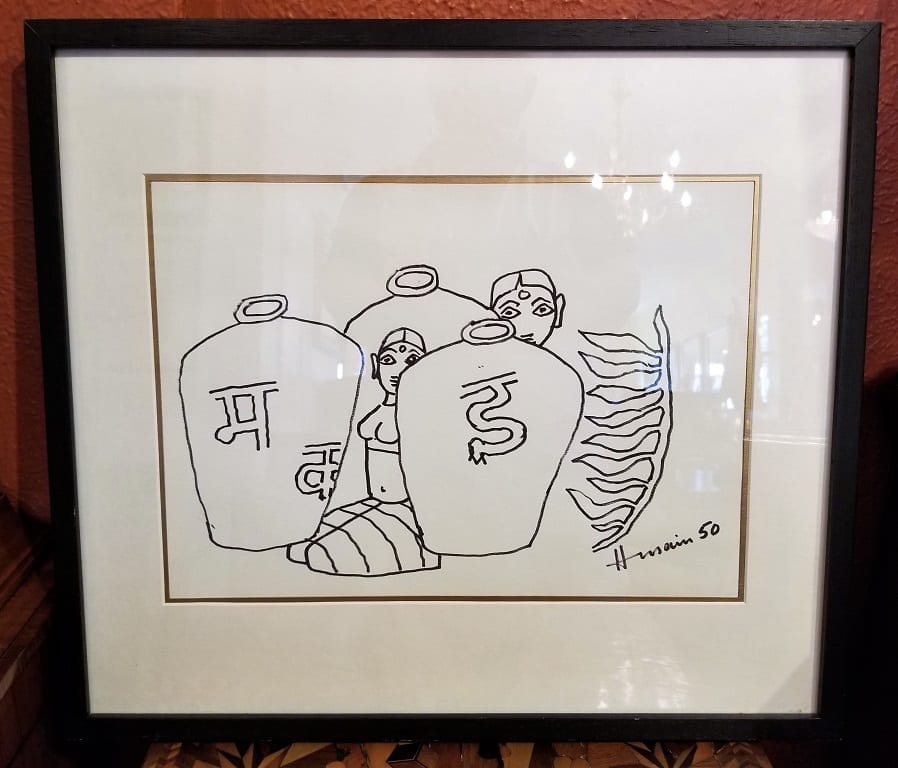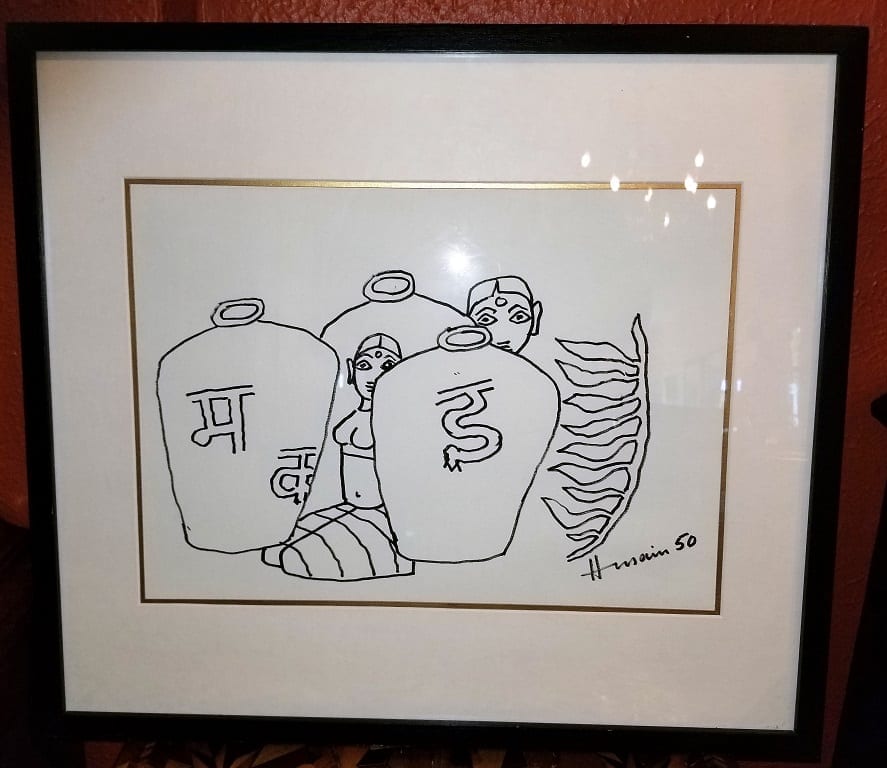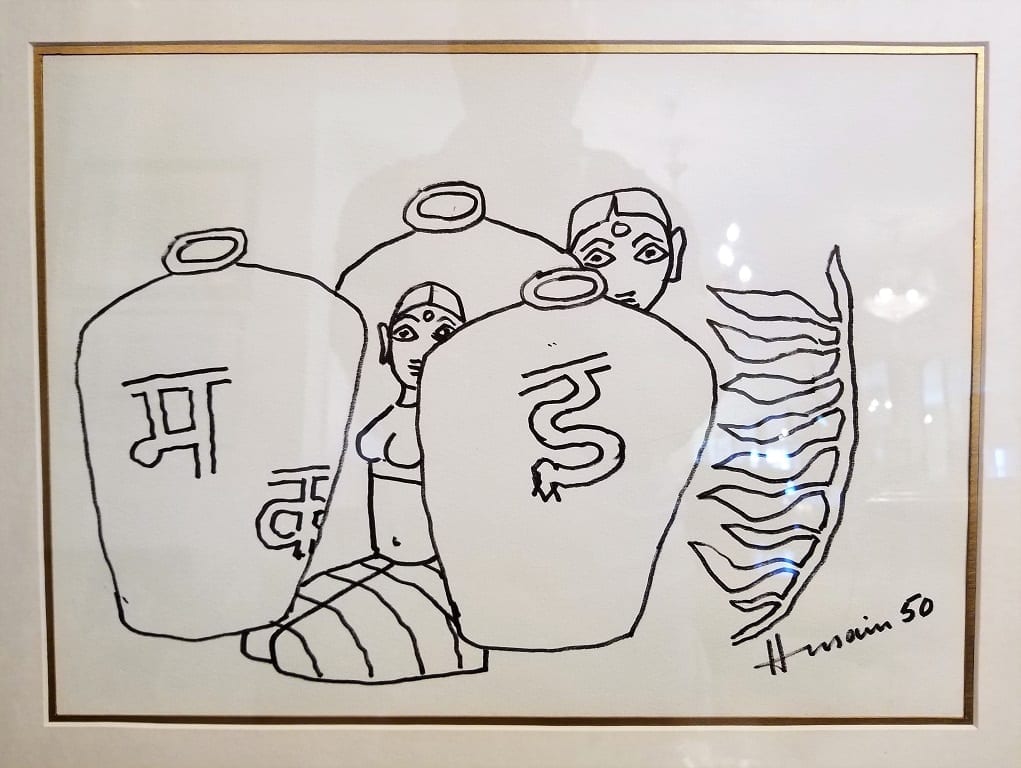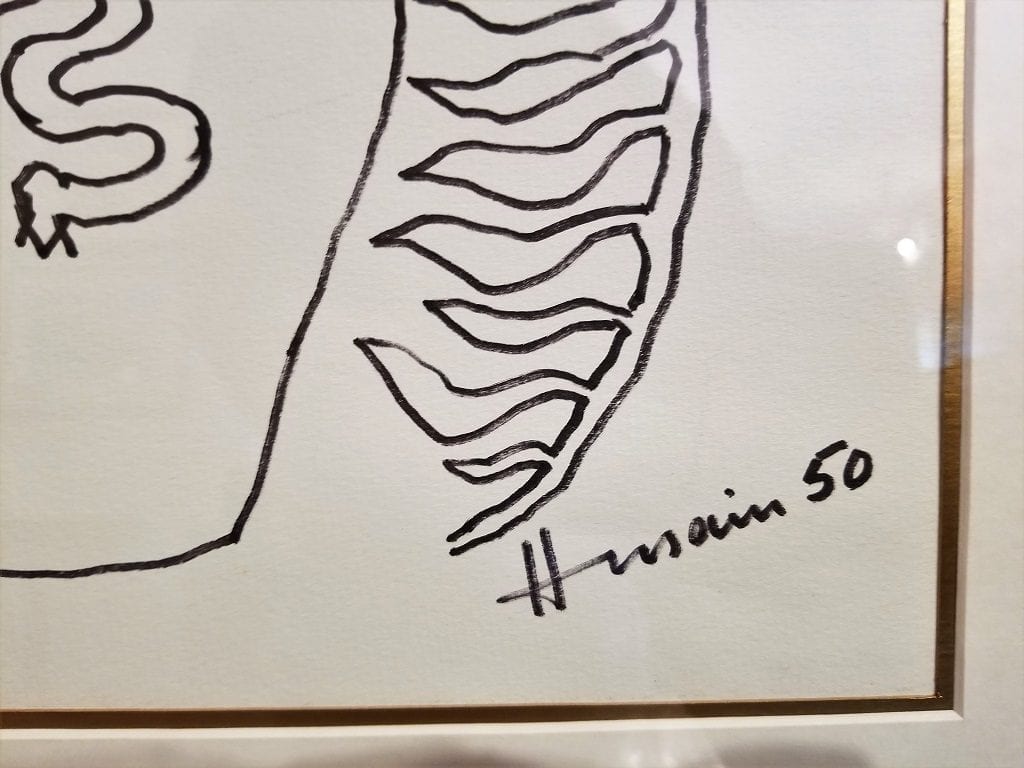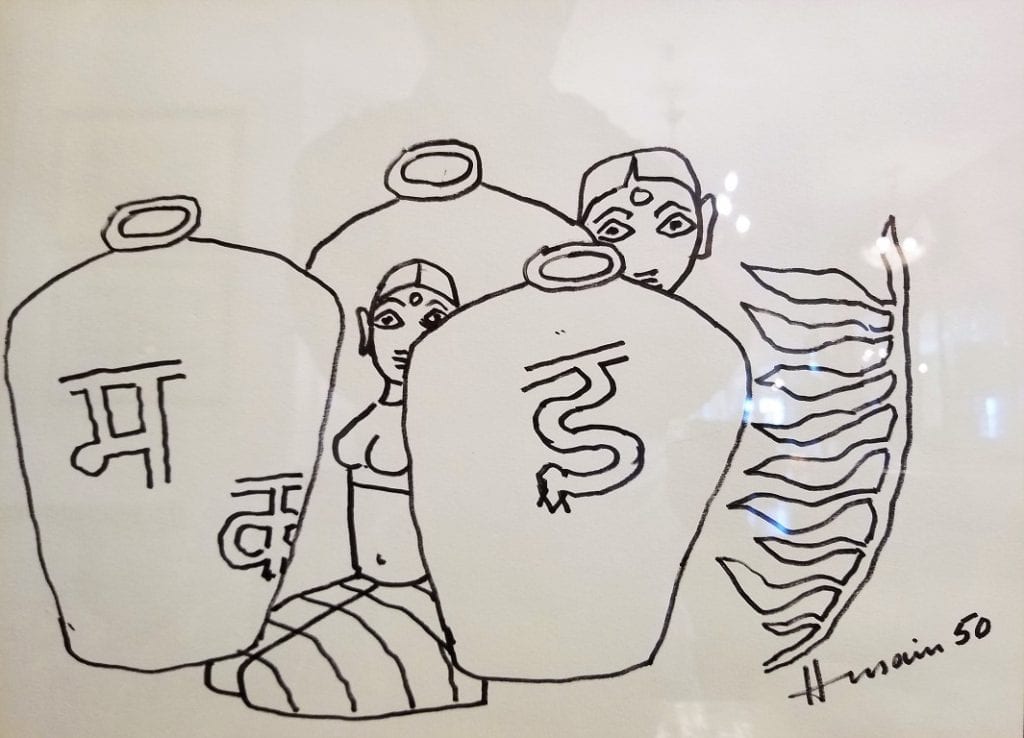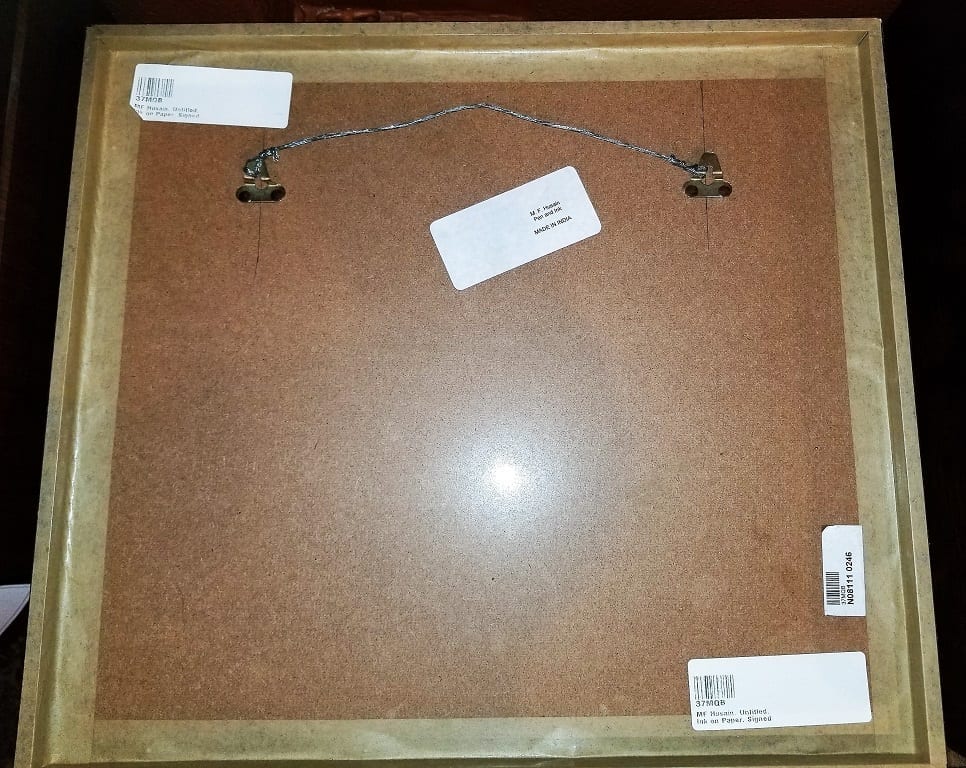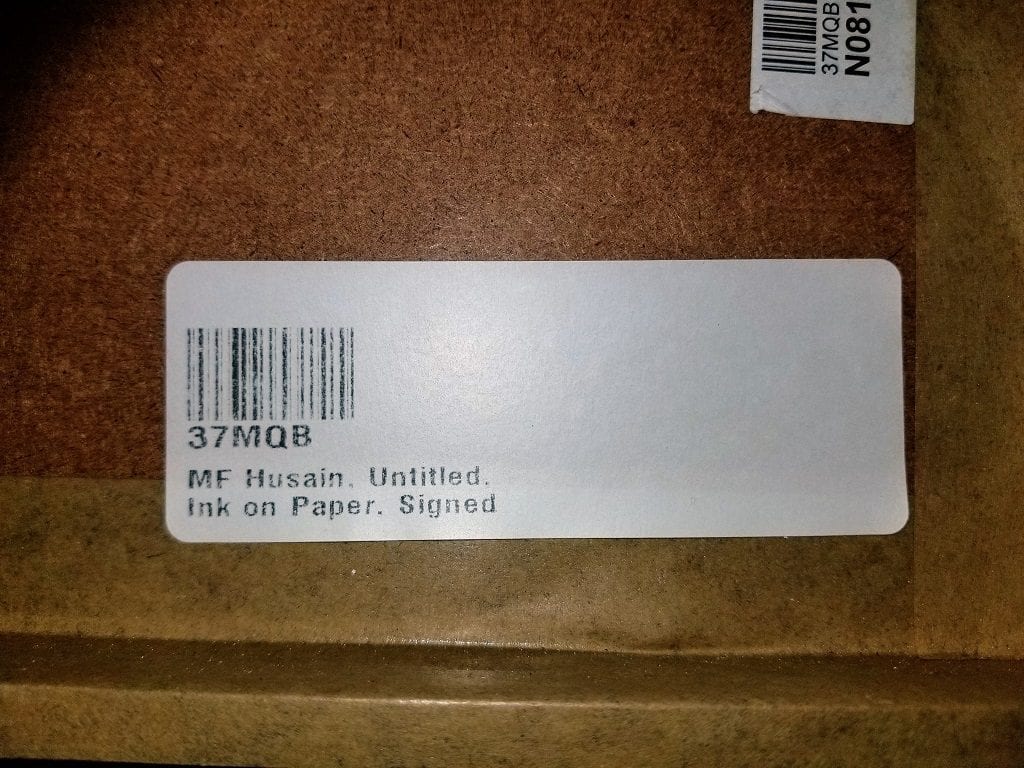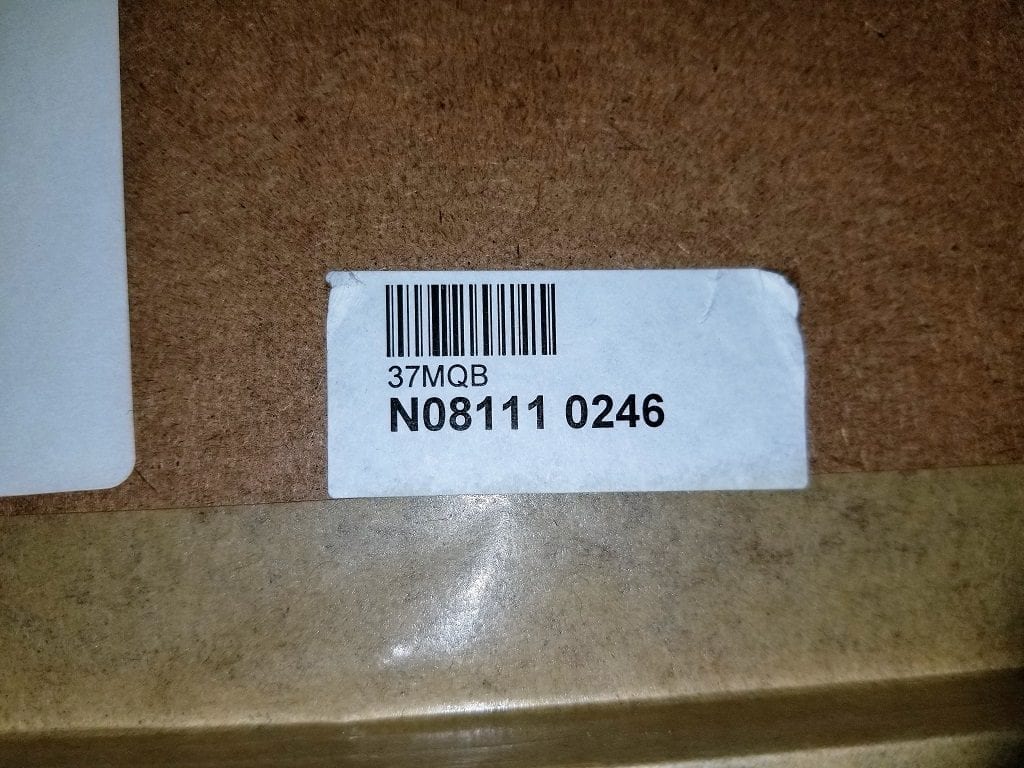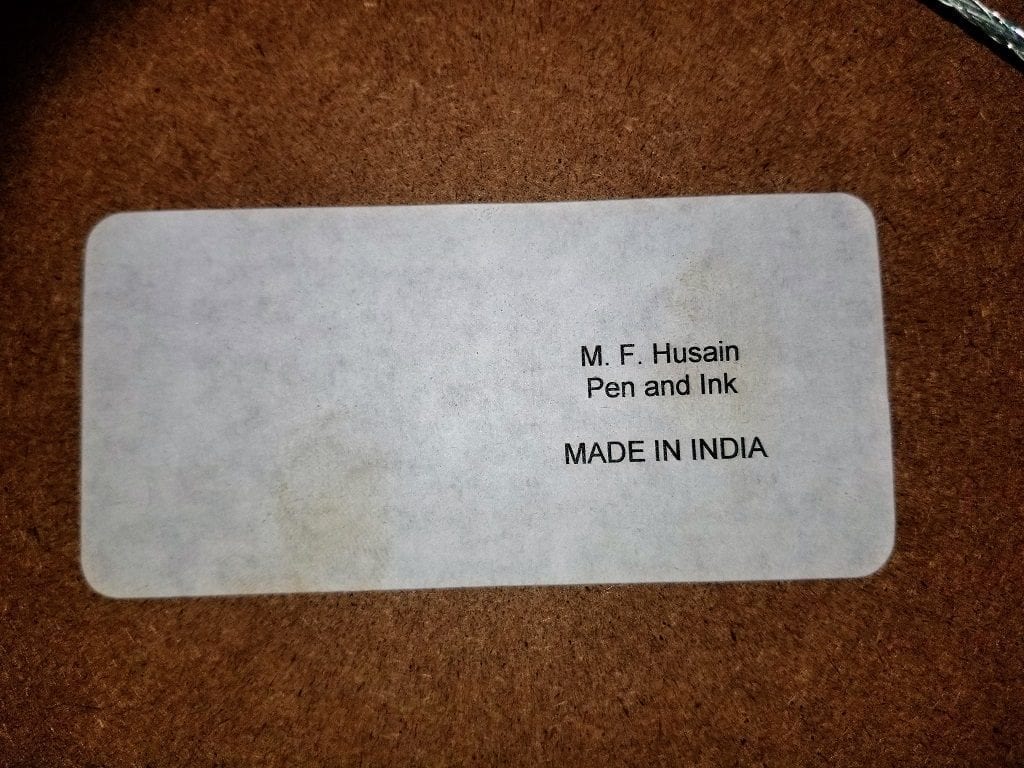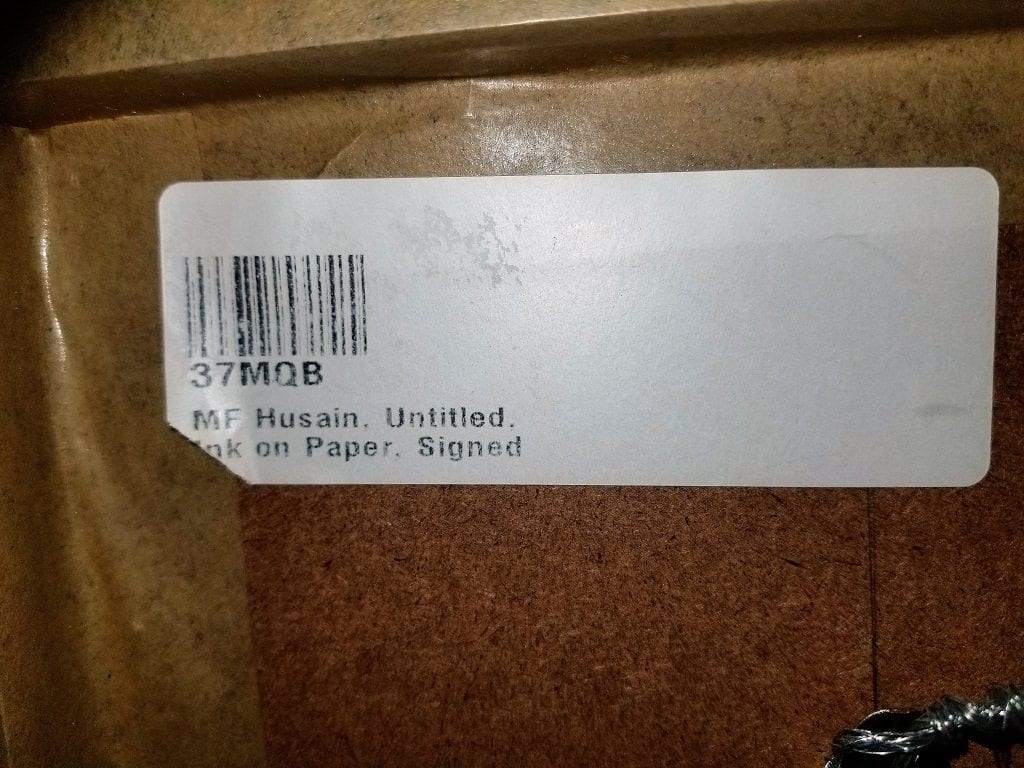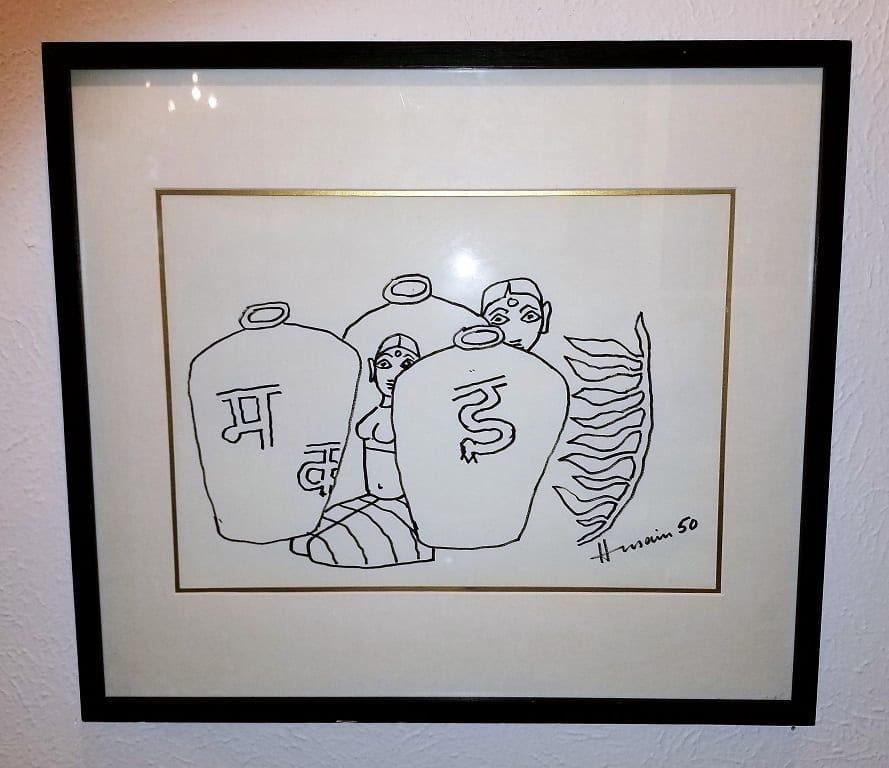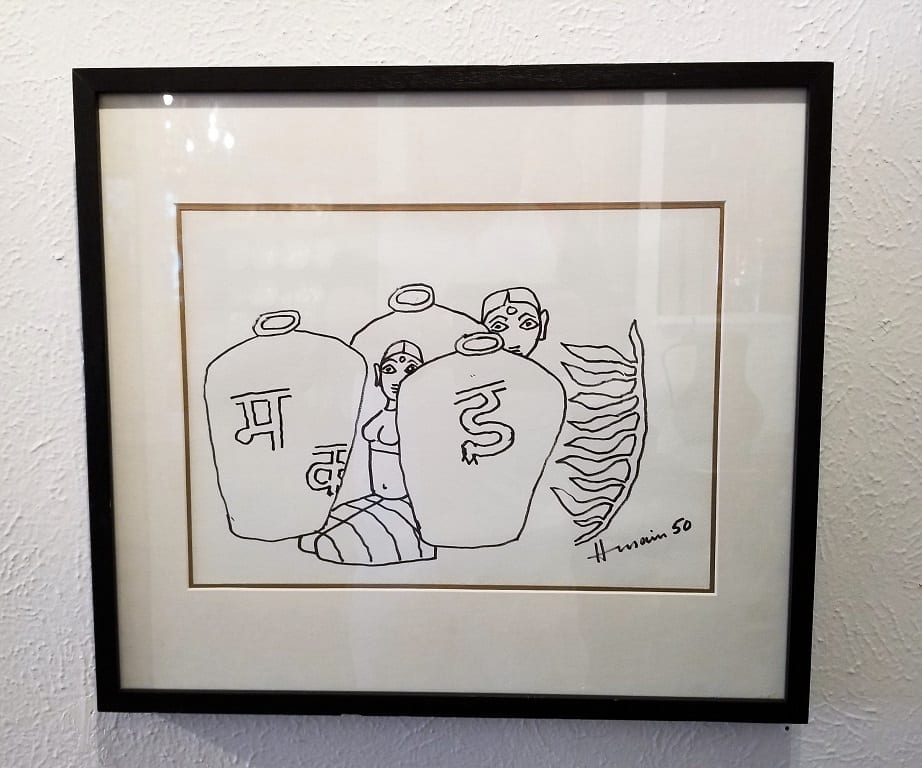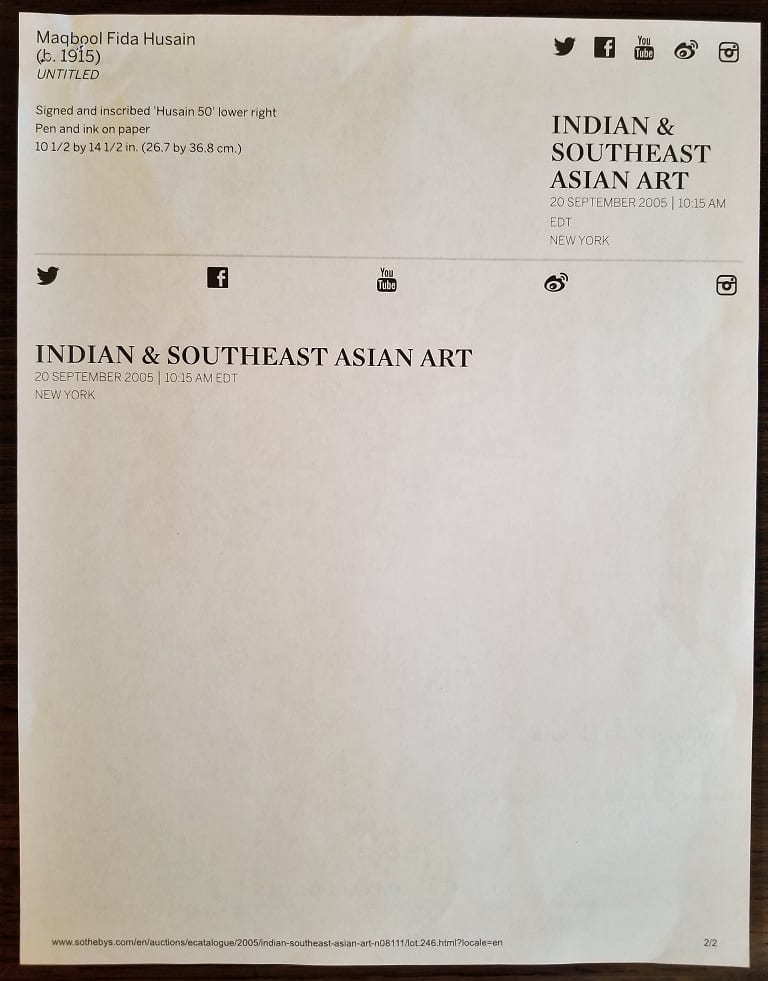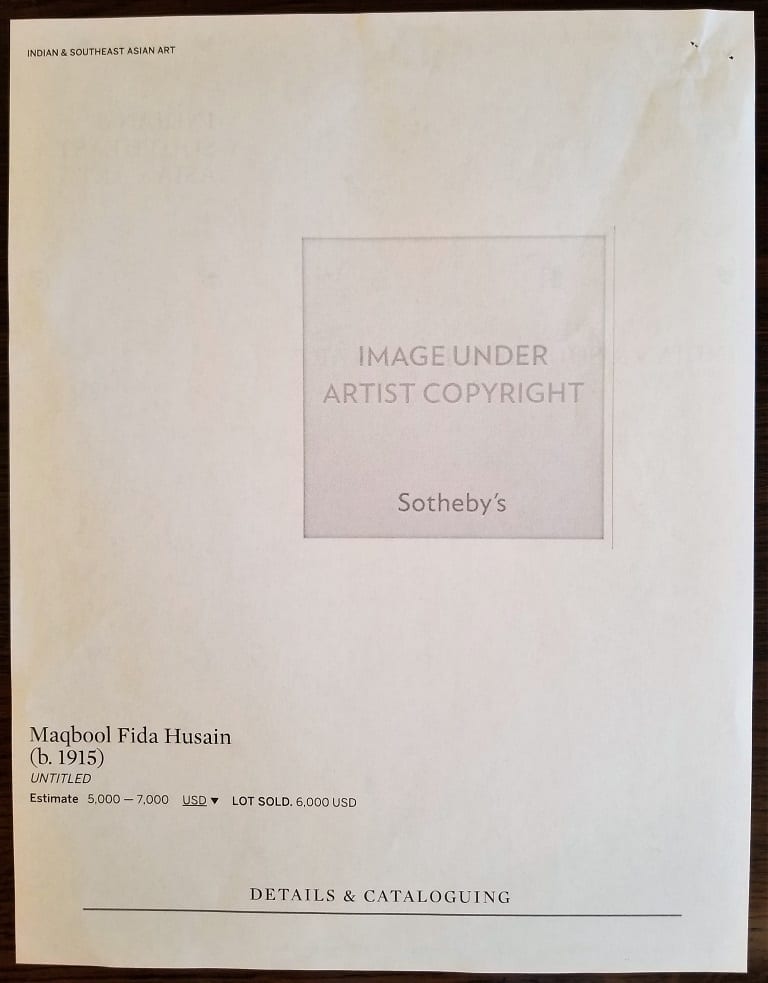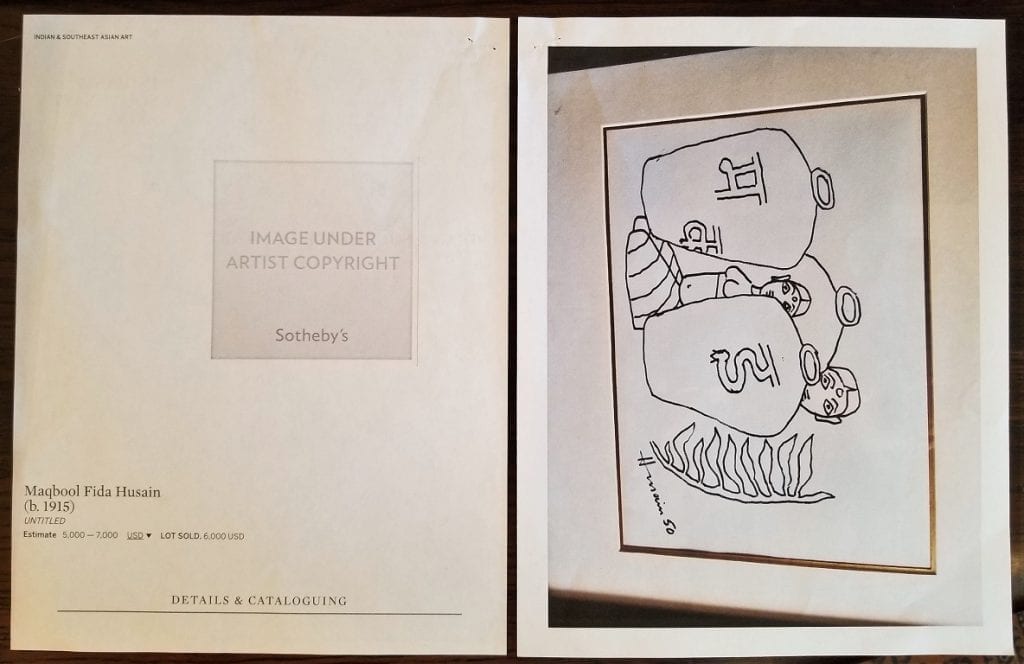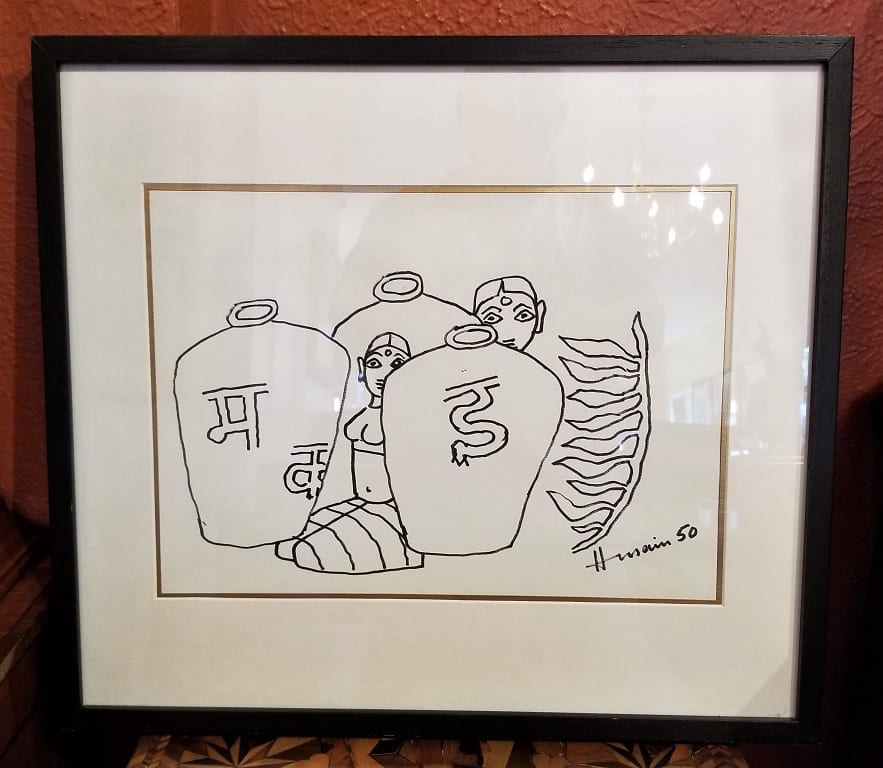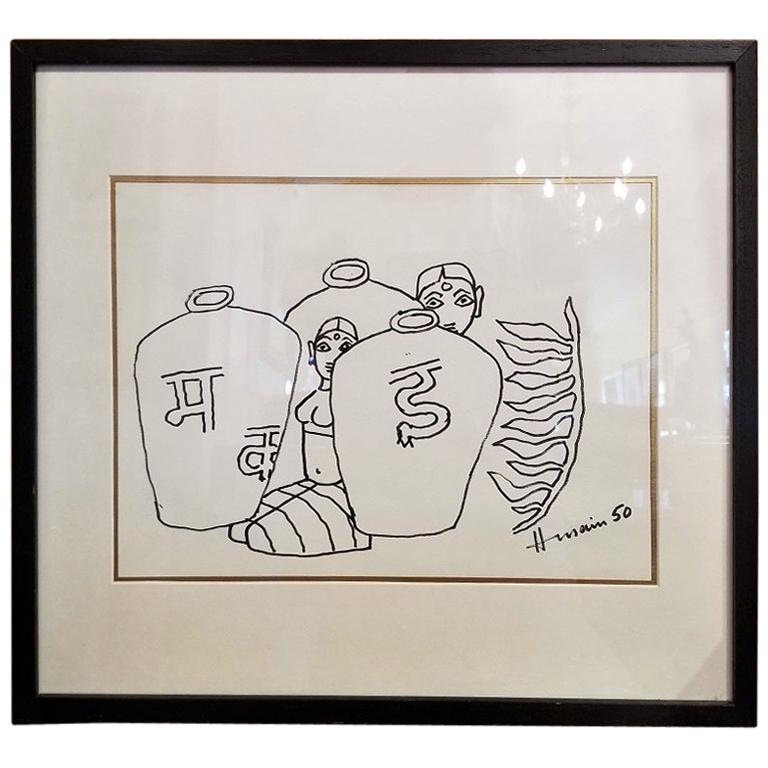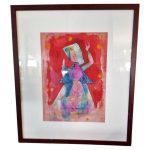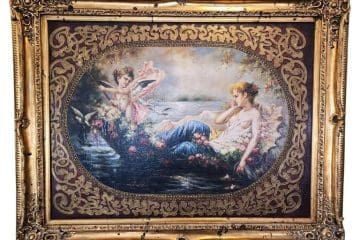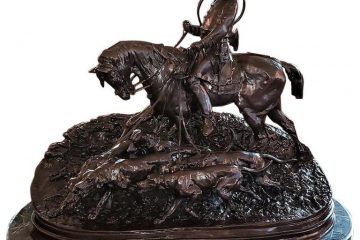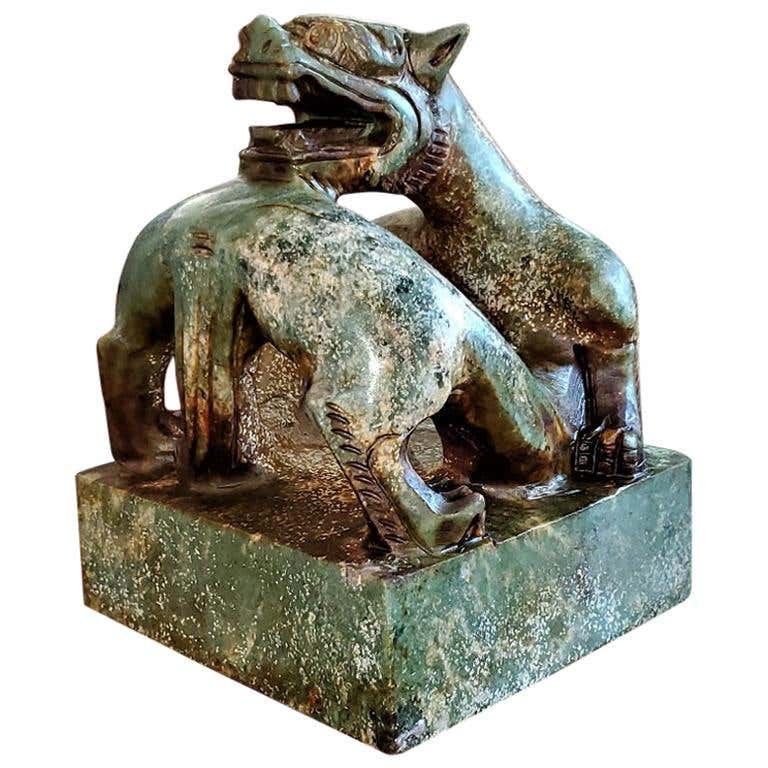Maqbool Fida Husain Pen & Ink on Paper Untitled 1950
PRESENTING a GLORIOUS & IMPORTANT Contemporary piece of Art by probably the most recognized Indian Master – Maqbool Fida Husain – Pen & Ink on Paper Untitled 1950.
Signed and dated 1950 on the bottom right.
This piece has impeccable Provenance !
It was purchased by a Private Dallas Collector at Sotheby’s New York Auction on 20th September 2005. Sale No: 8111 Lot No. 246.
Sotheby’s operate a twice yearly auction of Southeast Asian Art & Antiquities in New York in the months of March and September.
This sale was titled “Indian and Southeast Asian Art”.
The Lot is described as:
“Maqbool Fida Husain (b. 1915).
Signed and inscribed “Husain 50” lower right.
Pen and ink on paper.
10.5 by 14.5 in (26.7 by 36.8 cm).“
The painting carried an Auction estimate of $5,000 to $7,000 and Sold for $6,000 (not including Buyers Premium).
Allowing for inflation alone this would be over $11,500 in today’s value. At highest estimate, this would equate to $13,500 in today’s value.
As an added bonus and proof of authenticity the painting still retains it’s original Sotheby’s Lot No. Label.
It has substantially increased in value over the years as a HIGHLY DESIRABLE piece from an exhibited and highly collected Modern Indian Master painter.
M.F. Husain’s works have DRAMATICALLY increased in value and desirability since his death in 2011.
He is considered the “Picasso” of contemporary Indian painting.
This is a VERY IMPORTANT painting by Husain as it was done in 1950 and is therefore one of his EARLY WORKS and was painted shortly after Indian Independence in 1947.
It has 3 labels to the rear:
(1) Auction Label: “37MQB MF Husain. Untitled. Ink on paper. Signed”.
(2) Auction Label: “37MQB NO8111 0246” Sale & Lot No.
(3) “M.F. Husain, Pen and ink. Made in India”.
Maqbool Fida Husain (17 September 1915 – 9 June 2011) –
was an artist from India. He was a modern Indian painter of international acclaim, and a founding member of Bombay Progressive Artists’ Group.
Husain is associated with Indian modernism in the 1940s. His early association with the Bombay Progressive Artists’ Group used modern technique, and was inspired by the “new” India after The Partition of 1947. His narrative paintings, executed in a modified Cubist style, can be caustic and funny as well as serious and sombre. His themes—sometimes treated in series—include topics as diverse as Mohandas K. Gandhi, Mother Teresa, the Ramayana, the Mahabharata, the British raj, and motifs of Indian urban and rural life. Early in his painting career, and until his death, he enjoyed depicting the lively and free spirit of horses in many of his works.Husain is the most celebrated and internationally recognized Indian artist of the 20th century. Husain is primarily known for his paintings, but is also known for his drawings and his work as a printmaker, photographer, and filmmaker. Some of his later works stirred controversy, as they depicted traditional deities of India in non-traditional ways including nude portrayals of the deities.
He also directed a few movies. In 1967, he received the National Film Award for Best Experimental Film for Through the Eyes of a Painter. In 2004, he directed Meenaxi: A Tale of Three Cities, a film he worked on with his artist son Owais Husain, which was screened in the Marché du film section of the 2004 Cannes Film Festival.
Husain was born on 17 September 1915 in Pandharpur, Maharashtra to a Sulaymani Bohra family who trace their roots back to Gujarat within the last 200 years, and then originally to Yemen. He picked up taste in art through studying calligraphy while he stayed at a Madrasa in Baroda. Husain attended the Sir Jamsetjee Jeejebhoy School of Art in Mumbai. Early in his career Husain painted cinema posters in Mumbai. To earn extra money, he worked for a toy company designing and building toys. He often travelled to Gujarat to paint landscapes when he could afford to.
Husain developed his painting skills in the 1930s, painting billboards for the growing Bollywood film industry. This was a clique of young artists who wished to break with the nationalist traditions established by the Bengal school of art and to encourage an Indian avant-garde, engaged at an international level.
The artists cite “The Partition” of India and Pakistan 14 August 1947, with its resulting religious rioting and heavy loss of life as their reason for forming The Progressive Artist’s Group in Bombay in December 1947. The artists saw the Partition as a “turning point” for India, and their new style of art was urged on by, and was also a turning point for, (modern) Indian Art. Husain’s first solo exhibit was in 1952 in Zurich. His first U.S.A. exhibit was at India House in New York in 1964. his biography written by Akhilesh “Maqbool” is the most appreciated book published by Rajkamal Prakashan New Delhi.
1966 – 1990
He was awarded the prestigious Padma Shri in 1966. In 1967, he made his first film,Through the Eyes of a Painter It was shown at the Berlin International Film Festival and won a Golden Bear short film award.
Husain was a special invitee along with Pablo Picasso at the Sao Paulo Biennial, Brazil in 1971. He was awarded the Padma Bhushan in 1973 and was nominated to the Rajya Sabha in 1986. He was awarded the Padma Vibhushan in 1991.
1990 – 2005
His paintings allegedly hurt the religious sentiments of Hindu nationalist groups, which beginning in the 1990s mounted a campaign of protest against him. The paintings in question were created in 1970, but did not become an issue until 1996, when they were printed in Vichar Mimansa, a Hindi monthly magazine, which published them in an article headlined “M.F. Husain: A Painter or Butcher”. In response, eight criminal complaints were filed against him. In 2004, Delhi High Court dismissed these complaints of “promoting enmity between different groups … by painting Hindu goddesses – Durga and Sarswati, that was later compromised by Hindu fundamentalist groups.” In 1998 Husain’s house was attacked by Hindu fundamentalist groups like Bajrang Dal and art works were vandalised. The leadership of another fundamentalist political party Shiv Sena endorsed the attack. Twenty-six Bajrang Dalactivists were arrested by the police. Protests against Husain also led to the closure of an exhibition in England.
He has also produced & directed several movies, including Gaja Gamini (2000) (with his muse Madhuri Dixit who was the subject of a series of his paintings which he signed Fida). The film was intended as a tribute to Ms. Dixit herself. In this film she can be seen portraying various forms and manifestations of womanhood including the muse of Kalidasa, the Mona Lisa, a rebel, and musical euphoria. He also appeared in a scene in film Mohabbat, which had Madhuri Dixit in lead role. In the film, the paintings that were supposedly done by Madhuri were actually Husain’s. He went on to make Meenaxi: A Tale of Three Cities (with Tabu). The film was pulled out of cinemas a day after some Muslim organisations raised objections to one of the songs in it. The All-India Ulema Council complained that the Qawwali song Noor-un-Ala-Noor was blasphemous. It argued that the song contained words directly taken from the Quran. The council was supported by Muslim organisations like the Milli Council, All-India Muslim Council, Raza Academy, Jamiat-ul-Ulema-e-Hind and Jamat-e-Islami. Husain’s son stated that the words were a phrase referring to divine beauty that were being sung by the central character played by Tabu. He said there was no intention to offend. Following the wave of protests the enraged artist withdrew his movie from cinemas. The film was well received by the critics, however, and went on to win various awards.
2006 – 2011
In February 2006, Husain was charged with “hurting sentiments of people” because of his nude portraits of Hindu gods and goddesses. In addition, in 6 February 2006 issue, India Today, a national English weekly published an advertisement titled “Art For Mission Kashmir”. This advertisement contains a painting of {Bharatmata} (Mother India) as a nude woman posed across a map of India with the names of Indian States on various parts of her body. The exhibition was organised by Nafisa Ali of Action India – an (NGO) and Apparao Art Gallery. Organizations like VHP protested persistently against Husain displaying the painting on the websites and even in exhibitions in north Europe. As a result, Husain apologized and promised to withdraw the painting from an auction, which was later sold for Rs 80 lakh in the auction. The painting later appeared on Husain’s official website.
Husain became the best-paid painter in India, his highest-selling piece fetching $1.6 million at a 2008 Christie’s auction.
Hundreds of lawsuits in connection with Husain’s allegedly obscene art were outstanding as of 2007. A warrant was issued for his arrest after he did not appear at a hearing, though this warrant was later suspended.
Husain lived in self-imposed exile from 2006 until his death. He generally lived in Doha and summered in London. For the last years of his life Husain lived in Doha and London, staying away from India, but expressing a strong desire to return, despite fears of being killed.
In 2008 Husain was commissioned to create 32 large-scale paintings of Indian history. He finished 8 before his death. In 2010, he was conferred Qatari nationality, and he surrendered his Indian passport. In Qatar, he principally worked on two large projects, one on the history of Arab civilization, commissioned by Qatar‘s first lady, Mozah bint Nasser Al Missned, and one on the history of Indian civilization. The works are to be housed in a museum in Doha.
At the age of 92 Husain was given the prestigious Raja Ravi Varma award by the government of Kerala. The announcement led to controversy in Kerala and some cultural organisations campaigned against the granting of the award and petitioned the Kerala courts. Social Activist, Rahul Easwar, went to Kerala High Court and it granted an interim order to stay the granting of the award until the petition had been disposed of.
In 2010, the Jordanian Royal Islamic Strategic Studies Centre named Husain as one of the 500 most influential Muslims.
M. F. Husain died, aged 95, on 9 June 2011, following a heart attack. He had been unwell for several months. He died at the Royal Brompton Hospital in London, and was buried in Brookwood Cemetery on 10 June 2011.
Other Indian artists expressed criticism. Satish Gujral publicly asked Husain whether he would dare to portray Islamic figures similarly. However Gujral stated that he deeply regretted the way Husain was treated and forced into an exile because of what Gujral termed “the mob culture”.
Writing in The Pioneer, Chandan Mitra wrote, “As long as such a law exists in the statutes, nobody can be faulted for approaching the courts against Husain’s objectionable paintings, nor can the judiciary be pilloried for ordering action against the artist for his persistent and deliberate refusal to appear before the court.”
In response to the controversy, Husain’s admirers petitioned the government to grant Husain the Bharat Ratna, India’s highest award. According to Shashi Tharoor, who supported the petition, it praised Husain because his “life and work are beginning to serve as an allegory for the changing modalities of the secular in modern India – and the challenges that the narrative of the nation holds for many of us. This is the opportune and crucial time to honour him for his dedication and courage to the cultural renaissance of his beloved country.”
On his part Husain stated that leading Hindu leaders have not spoken a word against his paintings, and they should have been the first ones to have raised their voice and only people with political intentions created controversy.
After Husain’s death, Shiv Sena chief Bal Thackeray said, “He only slipped up on the depiction of Hindu gods and goddesses. Otherwise, he was happy and content in his field. If his demise is a loss for modern art, then so be it. May Allah give him peace!”
Legacy
On 17 September 2015, search engine Google commemorated M. F. Husain with a Doodle on his birth centenary.
Link: https://en.wikipedia.org/wiki/M._F._Husain
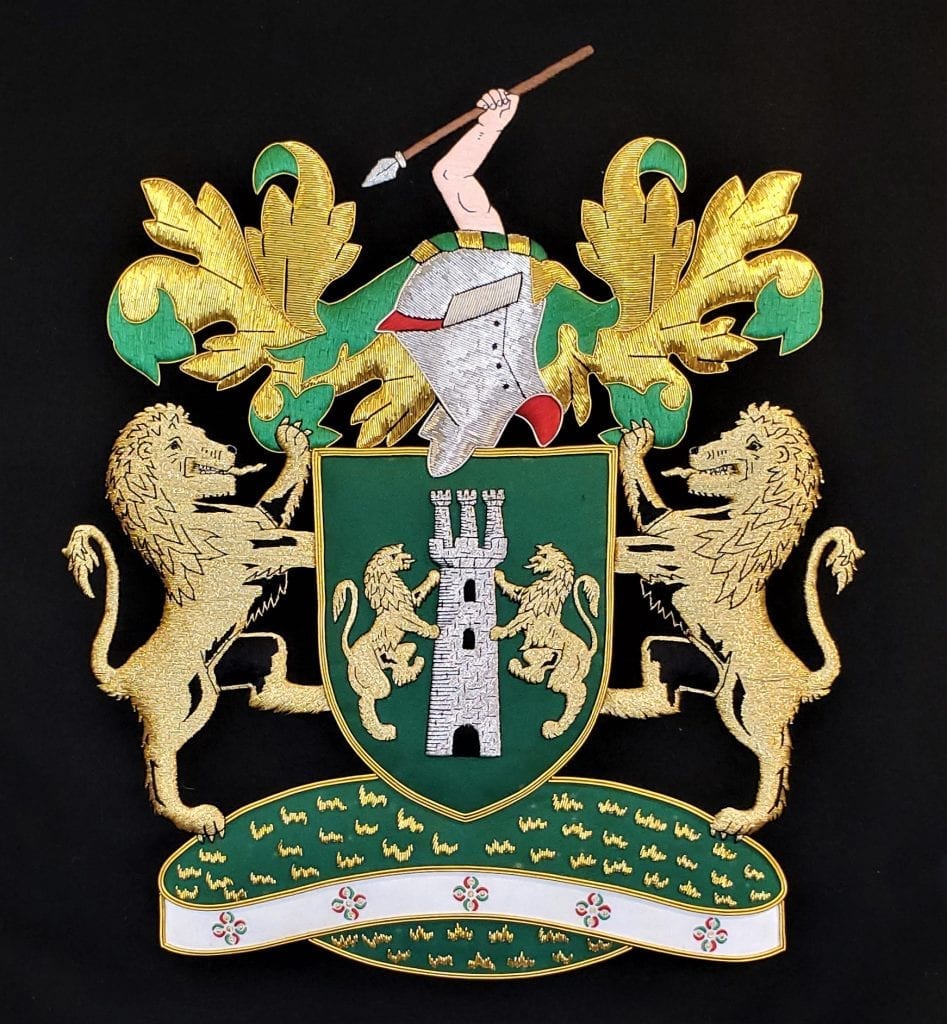

Maqbool Fida Husain Pen & Ink on Paper Untitled 1950
Provenance: See above. From a Private Dallas Collection.
Condition: Excellent (in original frame under glass).
Dimensions: Frame: 20″ x 17.75″ in
Panel: 10.5 x 14.5 in (26.7 x 36.8 cm)
SALE PRICE NOW: $36,500
